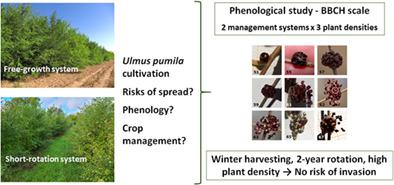当前位置:
X-MOL 学术
›
Ann. Appl. Biol.
›
论文详情
Our official English website, www.x-mol.net, welcomes your
feedback! (Note: you will need to create a separate account there.)
The influence of tree management practices on phenological growth stages of Ulmus pumila L. (Siberian elm)
Annals of Applied Biology ( IF 2.2 ) Pub Date : 2021-04-08 , DOI: 10.1111/aab.12696 María Cruz Amorós 1 , Pedro Vicente Mauri 1 , María Dolores Curt 2
Annals of Applied Biology ( IF 2.2 ) Pub Date : 2021-04-08 , DOI: 10.1111/aab.12696 María Cruz Amorós 1 , Pedro Vicente Mauri 1 , María Dolores Curt 2
Affiliation

|
There is a growing interest in Ulmus pumila L. as a forest plant species in harsh environments, as well as a woody short-rotation crop for biomass production in marginal lands. In countries where U. pumila is allochthonous, concerns have been raised on the easy spread of this species, on the grounds that it produces large quantities of wind-dispersed fruits with high potential germination success. Knowledge of the phenological responses of this species to management practices is essential to evaluate the risk of invasion to adjacent lands. This work addresses the phenology of U. pumila according the BBCH scale and the effect of short-rotation coppicing and plant density on phenological growth stages of this species. Results showed that there is little effect of plant density on the phenology of non-managed trees grown in regular plantations. On the contrary, short-rotation coppice influences greatly the vegetative and reproductive phenology of Siberian elm. High plant densities, winter harvesting and 2-year rotation guarantee that fruit dispersal will not happen.
中文翻译:

树木管理措施对榆树(西伯利亚榆树)物候生长阶段的影响
Ulmus pumila L. 作为恶劣环境中的森林植物物种,以及用于边缘土地生物质生产的木本短轮作作物,越来越受到人们的关注。在U. pumila是外来的国家,人们对该物种的容易传播表示担忧,理由是它产生大量具有很高潜在发芽成功率的随风传播的果实。了解该物种对管理实践的物候反应对于评估入侵邻近土地的风险至关重要。这项工作解决了U. pumila的物候学根据 BBCH 尺度以及短轮伐和植株密度对该物种物候生长阶段的影响。结果表明,种植密度对常规人工林中非管理树木物候的影响很小。相反,短轮伐林对西伯利亚榆树的营养和繁殖物候影响很大。高植物密度、冬季收获和 2 年轮作保证不会发生水果传播。
更新日期:2021-04-08
中文翻译:

树木管理措施对榆树(西伯利亚榆树)物候生长阶段的影响
Ulmus pumila L. 作为恶劣环境中的森林植物物种,以及用于边缘土地生物质生产的木本短轮作作物,越来越受到人们的关注。在U. pumila是外来的国家,人们对该物种的容易传播表示担忧,理由是它产生大量具有很高潜在发芽成功率的随风传播的果实。了解该物种对管理实践的物候反应对于评估入侵邻近土地的风险至关重要。这项工作解决了U. pumila的物候学根据 BBCH 尺度以及短轮伐和植株密度对该物种物候生长阶段的影响。结果表明,种植密度对常规人工林中非管理树木物候的影响很小。相反,短轮伐林对西伯利亚榆树的营养和繁殖物候影响很大。高植物密度、冬季收获和 2 年轮作保证不会发生水果传播。










































 京公网安备 11010802027423号
京公网安备 11010802027423号